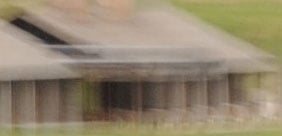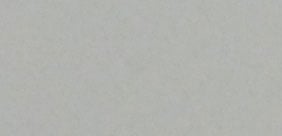Nikon D3000
-
-
Written by Gordon Laing
Nikon D3000 lenses and autofocus
The Nikon D3000 has an F-mount which can accommodate most Nikkor lenses, with the DX-format sensor resulting in their field of view being reduced by 1.5 times; so the DX 18-55mm VR kit lens delivers an effective focal range of 27-83mm.
As with all Nikon DSLRs, you’ll need recent lenses to support the full focusing and metering modes. There’s a compatibility chart in the D3000 manual or specification sheets, but just briefly you’ll need a Type G or D AF (including AF-S and AF-I) Nikkor to support all functions including the most sophisticated 3D Colour Matrix Metering II system.
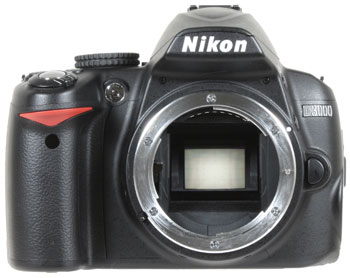 |
Like the D5000, D60, D40x and D40 before it, the D3000 does not feature a built-in motor required to auto-focus older lenses. These lenses will still work on the D3000, but they become manual-focus only.
The D3000 will only auto-focus with AF-S or AF-I CPU lenses from the Nikkor range. If you want autofocus from third party lenses, look for models with built-in focusing motors like Sigma’s HSM series.
Nikon omitted the AF motor to save size, weight and cost, and while its absence continues to prove frustrating to enthusiasts with older lenses, it’s less of an issue for the D3000’s target audience which will mostly buy newer AF-S zooms.
Nikon is also gradually releasing more AF-S prime lenses including the recent AF-S 50mm f/1.4G and AF-S DX 35mm f/1.8G. If the lack of a focusing motor is a deal-breaker for you though, trade-up to the D90 instead.
A great lens to compliment the DX 18-55mm VR kit lens is the DX 55-200mm VR telephoto zoom. This literally takes over where the kit zoom stops, greatly extending your reach to an equivalent of 300mm, while retaining valuable image stabilisation.
In our tests the DX 55-200mm VR is a surprisingly good performer for the money and highly recommended, although if you have a higher budget, the 70-300mm VR is even better. See our Nikkor DX 55-200mm VR review for more details, and look out for D3000 twin lens kits which come with both the DX 18-55mm VR and DX 55-200mm VR.
Nikkor DX 18-55mm VR stabilisation
The Nikon D3000 is typically sold in a kit with the Nikkor DX 18-55mm VR lens. The VR stands for Vibration Reduction and provides the lens with anti-shake capabilities which you can see through the viewfinder, although with a longest equivalent focal length of 83mm, any wobbling isn’t that obvious.
To test the stabilisation on the DX 18-55mm VR, we took a series of photos with it zoomed-into an equivalent of 83mm, where traditional photographic advice would recommend a shutter speed of around 1/80 to eliminate camera shake. Our sequence started at 1/100 and reduced by one stop each time until 1/6. We performed this sequence twice, first without VR enabled, and secondly with VR enabled. Below are 100% crops taken from the non-VR and VR images at a shutter speed of 1/10.
|
Nikon D3000 with Nikkor DX 18-55mm VR – Vibration Reduction off / on | ||
 | ||
100% crop, 18-55mm at 55mm, 1/10, 100 ISO, VR off |
100% crop, 18-55mm at 55mm, 1/10, 100 ISO, VR on | |
Without VR enabled, we found we needed a shutter speed of at least 1/80 to completely avoid camera shake, whereas with VR enabled, we could achieve the same effect at 1/10. This corresponds to just over three stops of compensation and is a valuable facility to have at your disposal. When buying the D3000 kit, be sure to verify you’re getting the DX 18-55mm VR lens, as some stores may swap-in the older non-VR version. While this older lens performs well optically, most people would prefer to have the benefit of stabilisation.
Nikon D3000 focusing
After three generations of entry-level DSLRs using a basic 3-point AF system, Nikon has performed a significant upgrade to the D3000 by equipping it with the same 11-point system as the D90 and D5000. This allows the D3000 to numerically leapfrog the Canon EOS 1000D / XS and Sony Alpha A230 with their 7 and 9-point AF systems respectively.
The D3000 employs the same Multi-CAM 1000 module as the D90 with a single cross-type sensor, and the options appear to be identical. As such there’s three main AF modes: AF-S (Single Servo AF), AF-C (Continuous Servo AF) and AF-A (an Auto mode which selects between them depending on whether the subject is in motion – this is the default option). These are selected from the main information display screen, where you’ll also be offered a Manual focusing option.
Unlike many budget DSLRs which strobe their built-in flashes for AF assistance, the D3000 employs a dedicated lamp – it’s still pretty bright, but much more discreet than the flash flickering. If desired though you can disable it from the main menus.
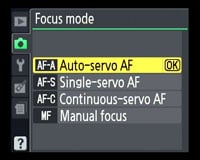 | 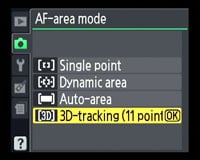 |
Like the D90 and D5000 before it, there’s four AF Area modes: Single Point, Dynamic Area, Auto Area, and 3D Tracking; 3D tracking was not available on the D60. In Single and Dynamic Area, you can manually adjust the focusing point using the multi-selector, with Dynamic Area also considering surrounding focus points if the subject moves. In Auto Area, the D3000 chooses the focus point automatically.
With 3D Tracking, you manually select a focusing point and place it over the desired subject. With the shutter-release half-pressed, the D3000 will then attempt to keep this subject in focus even if you recompose the shot. 3D Tracking also exploits colour information to help track a subject, although obviously if it’s the same colour as the background, the system will become confused. Nikon recommends using Dynamic Area for erratically moving subjects, and 3D Tracking when recomposing photos with relatively static subjects.
As you’d expect, the D3000’s phase-change AF system performed pretty much identically to the D90 and D5000, at least when equipped with the same lens. Set to the default Auto Area it generally did a good job of recognising the primary subject and locking the lens onto it, with the active AF points highlighted. In Dynamic mode with AF-C, subjects placed under the manually chosen focus point were tracked effectively as they moved towards or away from the camera.
Finally, the 3D Tracking option was effective at following subjects moving around the frame or as you recomposed with a static subject. This worked particularly well with strongly coloured subjects which stood out from the background, although as Nikon recommended, it’s best-suited to more leisurely motion. Technologically it’s also fun to watch the active AF point follow the subject around the frame, at least in the area covered by the 11 points, although in this regard Nikon’s semi-pro DSLRs with their 51-point AF systems are ultimately more impressive.
As with all DSLRs which offer a variety of AF options, it’s a case of experimenting to see which works best for your particular application. But if you’re shooting a subject in motion and can keep it within the diamond area covered by the 11 AF points, the D3000’s Dynamic Area and 3D Tracking modes should keep it sharp. Overall we found it a more capable and sophisticated system than that of its two main rivals, and it finally banishes the basic 3-point system of Nikon’s previous entry-level DSLRs.
Finally, an interesting feature inherited from the D60 is the Rangefinder option, enabled in the Viewfinder section of the Settings menu. This uses the exposure compensation scale in the viewfinder (but not on the main screen) to indicate focus distance while manually focusing. As you approach perfect focus, the scale reduces to just two markers either side of zero. As you’d expect for a camera at this price-point though, there’s no AF micro-adjustment.
Nikon D3000 metering, exposures and bracketing
The D3000’s mode dial offers the usual Program, Aperture, Shutter Priority and Manual modes along with full Automatic, Auto with flash-off, direct access to six popular scene presets and a GUIDE position which presents Nikon’s brand new help system described on the previous page.
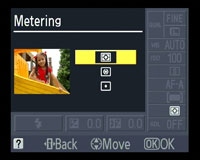 |
The Nikon D3000 shares the same three metering modes as the D60 before it: Spot, Centre-weighted and 3D Colour Matrix II, the latter employing a 420-segment RGB sensor. Like most settings on the D3000, these are adjusted through the main information screen system.
Note you’ll need a type G or D lens to deliver distance information for the 3D system, otherwise the D3000 falls back on Colour Matrix Metering II.
The D3000 offers shutter speeds from 1/4000 to 30 seconds plus a Bulb option. Exposure compensation is available in a wide range of +/-5EV in 0.3 steps. Nikon doesn’t quote a life for the shutter block, but we expect it to be closer to the 100,000 cycles of the D5000 and D90, as oppose to the 150,000 on the D300s and 300,000 on the D3.
Bizarrely, the earlier D60 didn’t offer any exposure bracketing, and annoyingly Nikon hasn’t taken the opportunity to equip the D3000 with any either. This is a strange omission considering even basic three-frame bracketing is a standard feature on almost any camera we can think of. It’s even odder when you consider Nikon takes pride in offering more powerful bracketing facilities than its rivals on its semi-pro models. Maybe it’s a case of differentiation, forcing you to trade-up to the D5000 if you want basic three-frame bracketing. A foolish strategy in our view, as anyone who really wants bracketing on a budget is more likely to consider Canon or Sony’s models instead.
Nikon D3000 anti-dust
The Nikon D3000 employs the same methods to physically combat dust as its predecessor: a vibrating low pass filter and Nikon’s Airflow system which exploits air pressure within the body as the mirror flips to propel particles out of a series of tiny holes in the camera. The D3000 also supports recording of a dust reference frame for automatic digital removal of dust later, but for that you’ll need the optional Capture NX 2 software.
By default, the sensor vibration takes place every time you power the camera on or off, accompanied by an animated graphic, although you can select whether you’d prefer it to only occur at power up, power down, or not at all. The process takes about two seconds during startup, but you can interrupt it by pressing the shutter release.
To put the D3000’s anti-dust systems to the test, we followed our usual DSLR torture-test of leaving the body face-up without a lens, inside and outside for ten minutes each; we can’t know how much dust entered the body during this time, nor even how much was present to start with, but we know such a process would result in dust being a problem for most models. We then powered the camera on and off twice to vibrate the filter with the camera facing down.
We then took a series of photos at every aperture setting of a plain white surface at close range with the kit lens zoomed-in and focused to infinity. Dust marks normally become most apparent at the smallest apertures (eg f16 and f22), but it’s also important to test at more common apertures.
|
Nikon D3000 dust example at f22 / f22 with Auto Levels | ||
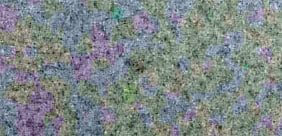 | ||
100% crop, 18-55mm at 55mm, f22 |
100% crop, 18-55mm at 55mm, f22 | |
When the aperture is closed to f22, you’re normally looking at a worse-case scenario with few cameras able to avoid showing any dust marks. Remarkably though even after ten minutes inside and out without a lens, our f22 image showed no obvious marks. Believe it or not, the worst example is pictured above left. To the right we’ve applied Auto Levels to the same area to reveal the mark, but even then it remains fairly discreet.
This is a great result for the D3000, which unlike its predecessor in the same test, managed to avoid any undesirable dust marks. Of course this could be a lucky result for the D3000, but as always it’s useful to gather anecdotal evidence for the bigger picture, and certainly in our tests, the D3000 performed well when it came to combating dust. That said, we’d still recommend every DSLR owner invests in a decent blower like the Giotto’s Rocket to help remove any stubborn particles, as you’ll inevitably come across one at some point.
Finally, the D3000 also supports recording of a dust reference frame for automatic digital removal of dust later, but for that you’ll need to shoot in RAW and buy the optional Capture NX software.
Nikon D3000 sensor and processing
The Nikon D3000 shares the same 10.2 Megapixel CCD sensor as its predecessor, and the D40x and D80 before that. This measures 23.6×15.8mm and delivers 3:2 aspect ratio images with a maximum size of 3872×2592 pixels, and there’s the choice of two lower resolutions. This makes it the last model in Nikon’s current DSLR range not to make the switch to CMOS technology.
Images can be saved with Basic, Normal or Fine JPEG compression, or recorded as a 12-bit compressed RAW file either by itself or accompanied with a Basic quality JPEG. Best quality Large Fine JPEGs typically measure between 4 and 5MB each, while RAW files measure around 8MB each. There’s no dedicated button for the quality settings, so like adjusting the other settings, you’ll either need to press the ‘i’ button and highlight the desired item, or enter the main menu system.
Like Nikon’s other consumer DSLRs, there’s only basic software supplied for converting RAW files – you’ll need to invest in Capture NX 2 or third party software to do any more sophisticated processing. On the upside, the D3000 allows processing of RAW files in-camera, although you can only adjust the resolution, compression, white balance, exposure compensation and the Picture Control.
Like its predecessor, the D3000 offers sensitivity from 100 to 1600 ISO with a Hi1 option offering an equivalent of 3200 ISO. Noise Reduction is Off by default, but still applied at sensitivities of 1600 and 3200 ISO. Alternatively you can enable Noise Reduction which is then applied at sensitivities over 400 ISO and exposures longer than eight seconds.
The D3000 employs much the same image processing options as its predecessor, and therefore misses out on some of the features we’ve become used to on higher-end Nikon DSLRs; for example there doesn’t appear to be any in-camera correction of coloured fringing or geometric distortion. Active D-Lighting is also still limited to the on or off options of the D60, rather than the six settings on models like the D5000.
It’s not all the same though, with the previous Optimise Image presets for contrast, sharpness and saturation now switched for the Picture Controls of its modern counterparts; indeed the implementation is the same as the D5000 and D90. As such, you have the choice of Standard, Neutral, Vivid, Portrait and Landscape Picture Controls, all offering adjustment of Sharpening (0-9), Contrast (+/-3), Brightness (+/-1), Saturation (+/-3) and Hue (+/-3), while the Monochrome Picture Style swaps Saturation and Hue for four Filter and nine Toning effects, with each of the latter offering seven fine-tuning steps. If you’re in a real hurry, a Quick Adjust option can boost or lessen a group of settings in one go.
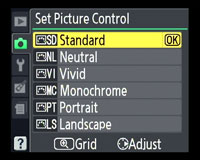 |
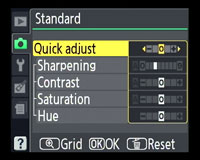 |
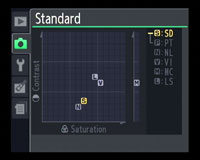 |
As always we used the default processing option for our test shots – in this instance the Standard Picture Control. As you’ll see in our Results and Sample Images Gallery pages, the D3000’s default JPEG output is quite different from its predecessor. The D60 delivered highly vibrant, punchy images out of the camera, which under bright conditions could become unrealistically over-saturated. In contrast, the D3000, like other recent Nikon DSLRs, is much more refrained.
Indeed next to its rivals from Canon and Sony, the D3000’s default output can appear quite subdued and relatively soft, and this can come as a considerable surprise if you’re upgrading from a point-and-shoot model. If you miss a more vibrant approach to processing though, simply opt for the Vivid Picture Control as your default, or manually tweak the colour and tone settings until you get the result you desire. Better still, shoot in RAW and make the adjustments later.
There’s still a wide array of white balance settings including seven types of fluorescent lighting and the opportunity to fine tune presets or of course take a custom reading.
The D3000 inherits the Active D-Lighting capabilities of the D60, although as mentioned above, it’s either on or off here, as oppose to having the six settings of models like the D5000. The theory’s still the same though: Active D-Lighting applies tonal compensation when you take the shot which claims to preserve details in highlight and shadow areas. This works by first reducing the exposure, then adjusting the highlights, shadow and mid-tone areas before recording the image. There’s a slight delay while this takes place.
|
Nikon D3000 Active D-Lighting off (default) / on | ||
 | ||
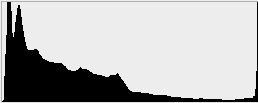 | 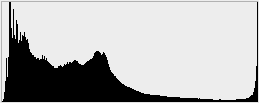 | |
Active D-Lighting Off: 100 ISO, f3.6, 1/6 sec |
Active D-Lighting On: 100 ISO, f3.5, 1/10 sec | |
We found Active D-Lighting was reasonably effective at retrieving detail in shadows and previously blown highlights, although the technique inevitably resulted in greater visible noise in those boosted darker areas. As such, you may only want to use it in challenging lighting situations where you don’t want to (or can’t) do processing in software later. Interestingly, unlike the D5000 and D90, Active D-Lighting is disabled by default here – just like the earlier D60.
Nikon D3000 drive modes and continuous shooting
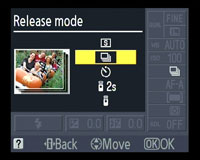 |
The Nikon D3000 shares the same continuous shooting specification as its predecessor: namely 3fps, although this will reduce if you’re applying noise reduction or the highest sensitivity. Obviously the delay incurred by Active D-Lighting also rules out practical continuous shooting.
Using a formatted Lexar Professional 133x 8GB SDHC card and with the shutter speed set to 1/250, we fired-off 50 Large Fine JPEGs in 17 seconds, corresponding to a rate of about 2.95fps. The D3000 seemed happy to keep shooting while memory remained.
With the D3000 set to record RAW files, we managed to shoot six frames in just two seconds before a slight pause, again resulting in a rate of just under 3fps. So pretty normal continuous shooting for a budget DSLR, although faster than the Sony A230, and also an improvement over the earlier D60, at least in terms of continuing to shoot JPEGs while memory remains.
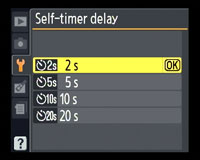 |
By default, the self-timer is set to 10 seconds, but one of the custom modes allows you to change this to 2, 5 or 20 seconds if preferred. Sadly there’s no mirror lockup option though, despite the capability being built-into the camera to allow manual sensor cleaning.
Finally, it is possible to remote control the D3000 using a computer and save the images direct to your hard disk, but you’ll need the optional Nikon Camera Control Pro software to do so.
Now let’s see how Nikon’s latest entry-level DSLR compares in terms of image quality against its two biggest rivals from Canon and Sony in our Nikon D3000 results.
